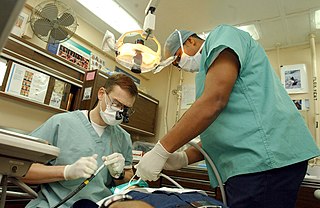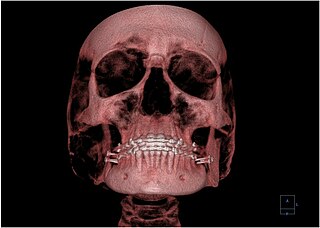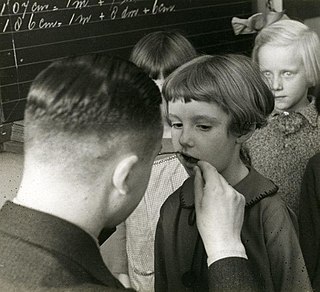Related Research Articles

A dentist, also known as a dental surgeon, is a health care professional who specializes in dentistry, the branch of medicine focused on the teeth, gums, and mouth. The dentist's supporting team aids in providing oral health services. The dental team includes dental assistants, dental hygienists, dental technicians, and sometimes dental therapists.
Doctor of Medicine is a medical degree, the meaning of which varies between different jurisdictions. In the United States, and some other countries, the M.D. denotes a professional degree. This generally arose because many in 18th-century medical professions trained in Scotland, which used the M.D. degree nomenclature. In England, however, Bachelor of Medicine, Bachelor of Surgery (M.B.B.S.) was used: in the 19th century, it became the standard in Scotland too. Thus, in the United Kingdom, Ireland and other countries, the M.D. is a research doctorate, honorary doctorate or applied clinical degree restricted to those who already hold a professional degree (Bachelor's/Master's/Doctoral) in medicine. In those countries, the equivalent professional degree to the North American, and some others' usage of M.D. is still typically titled Bachelor of Medicine, Bachelor of Surgery.
A medical school is a tertiary educational institution, professional school, or forms a part of such an institution, that teaches medicine, and awards a professional degree for physicians. Such medical degrees include the Bachelor of Medicine, Bachelor of Surgery, Master of Medicine, Doctor of Medicine (MD), or Doctor of Osteopathic Medicine (DO). Many medical schools offer additional degrees, such as a Doctor of Philosophy (PhD), master's degree (MSc) or other post-secondary education.
The United States Medical Licensing Examination (USMLE) is a three-step examination program for medical licensure in the United States sponsored by the Federation of State Medical Boards (FSMB) and the National Board of Medical Examiners (NBME). Physicians with a Doctor of Medicine (MD) degree are required to pass the USMLE for medical licensure. However, those with a Doctor of Osteopathic Medicine degree (DO) are required to take the COMLEX-USA (COMLEX) exams but may also sit for the USMLE as well.
Oral and maxillofacial surgery is a surgical specialty focusing on reconstructive surgery of the face, facial trauma surgery, the oral cavity (mouth), head and neck, and jaws, as well as facial cosmetic surgery/facial plastic surgery including cleft lip and cleft palate surgery.
Prosthodontics, also known as dental prosthetics or prosthetic dentistry, is the area of dentistry that focuses on dental prostheses. It is one of 12 dental specialties recognized by the American Dental Association (ADA), Royal College of Surgeons of England, Royal College of Surgeons of Edinburgh, Royal College of Surgeons of Ireland, Royal College of Surgeons of Glasgow, Royal College of Dentists of Canada, and Royal Australasian College of Dental Surgeons. The ADA defines it as "the dental specialty pertaining to the diagnosis, treatment planning, rehabilitation and maintenance of the oral function, comfort, appearance and health of patients with clinical conditions associated with missing or deficient teeth or oral and maxillofacial tissues using biocompatible substitutes."
A number of professional degrees in dentistry are offered by dental schools in various countries around the world.
Southern Regional Testing Agency (SRTA) is one of five examination agencies for dentistry in the United States. Some of the other examination agencies are, Western Regional Examining Board, Central Regional Dental Testing Service, Northeast Regional Board of Dental Examiners. These were organized to better standardize clinical exams for licensure.
The Comprehensive Osteopathic Medical Licensing Examination of the United States (COMLEX-USA) is a series of three osteopathic medical licensing examinations administered by the National Board of Osteopathic Medical Examiners (NBOME) similar to the United States Medical Licensing Examination (USMLE). COMLEX-USA is the most common pathway by which osteopathic physicians (D.Os) apply for medical licensure, and is accepted in all 50 states. The 3-digit standard scores of COMLEX-USA Level 1, Level 2- Cognitive Evaluation (CE), and Level 3 have a range of 9-999 and a mean of 500. Most candidates score between 250 and 800. 400 is the minimum passing score for COMLEX-USA Levels 1 and 2; 350 for COMLEX-USA Level 3. It was announced on January 24, 2022, that the COMLEX-USA Level 1 examination will be moving from a 3-digit numeric score to solely pass/fail beginning on May 10, 2022.

The National Board of Chiropractic Examiners (NBCE) is a non-profit national and international testing organization for the chiropractic profession that develops, administers, analyzes, scores, and reports results from various examinations. Examinations are offered to students at chiropractic colleges accredited by the Council on Chiropractic Education (CCE). The NBCE maintains its headquarters in Greeley, Colorado. The organization was established in 1963 to standardize chiropractic testing requirements as opposed to each state having its own board exam. Since 1963, all but one of states have adopted the passage of Parts I-IV; however, each state has its own licensing requirements in addition to the NBCE exams.
The University of the East College of Dentistry was first established as a unit of the Philippine College of Commerce and Business Administration in 1948. The college is one of the pioneers of dental education and labeled as one of the top dental schools in the Philippines.

Dentistry throughout the world is practiced differently, and training in dentistry varies as well.

Oral and maxillofacial radiology, also known as dental and maxillofacial radiology, or even more common DentoMaxilloFacial Radiology, is the specialty of dentistry concerned with performance and interpretation of diagnostic imaging used for examining the craniofacial, dental and adjacent structures.

The Ohio State University College of Dentistry is one of the graduate and professional schools of Ohio State University. The college is the fourth largest public dental school in the U.S. and consists of nine academic divisions representing all major dental specialties. In addition to the Doctor of Dental Surgery (D.D.S.) and Bachelor of Science in Dental Hygiene degrees, the Ohio State College of Dentistry offers specialty training programs, advanced training programs, MS programs, and a Ph.D. program in Oral Biology. Outreach and Engagement activities include over 60 active programs and more than 42 extramural sites, which continue to expand.
The National Dental Examining Board of Canada, also known as the NDEB, is the organization that is responsible for granting approval for dentists to practice in Canada through standardized examinations. Its headquarters are in Ottawa.
The practice of dentistry in Canada is overseen by the National Dental Examining Board of Canada in conjunction with other agencies, such as the Commission on Dental Accreditation of Canada and the Royal College of Dentists of Canada. In 2013 there were 21,109 dentists in Canada according to the Canadian Dental Association.

Pediatric dentistry is the branch of dentistry dealing with children from birth through adolescence. The specialty of pediatric dentistry is recognized by the American Dental Association, Royal College of Dentists of Canada, and Royal Australasian College of Dental Surgeons.
The practice of dentistry in the United States is overseen by several agencies, including the American Dental Association, the Commission on Dental Accreditation, and the regional boards. Ultimate licensure is the responsibility of individual states. There are roughly 190,000 practicing dentists in the United States.
In the United States and Canada, there are twelve recognized dental specialties in which some dentists choose to train and practice, in addition to or instead of general dentistry. In the United Kingdom and Australia, there are thirteen.

Nishtar Medical University is a public medical university located in Multan, Punjab, Pakistan. It is one of the oldest medical institutions established after the creation of Pakistan. It offers degree programs in medicine, dentistry, allied health sciences and nursing. It is named after Sardar Abdur Rub Nishtar, Pakistan movement leader, and then Governor of Punjab, Pakistan.
References
- ↑ "The Future of Licensure". Understanding Licensure. American Dental Association. Retrieved 31 July 2011.
- ↑ "National Board Dental Examination Part I 2011 Guide" (PDF). Eligibility for Reexamination. Joint Commission on National Dental Examinations. p. 5. Retrieved 31 July 2011.
- ↑ "National Board Dental Examination Part II 2011 Guide" (PDF). Eligibility for Reexamination. Joint Commission on National Dental Examinations. p. 5. Retrieved 31 July 2011.
- ↑ Wysocki, Eddie. "Board Scores Get the Ax: Does This New Change Pass or Fail?". ASDA blog. Retrieved 29 December 2012.